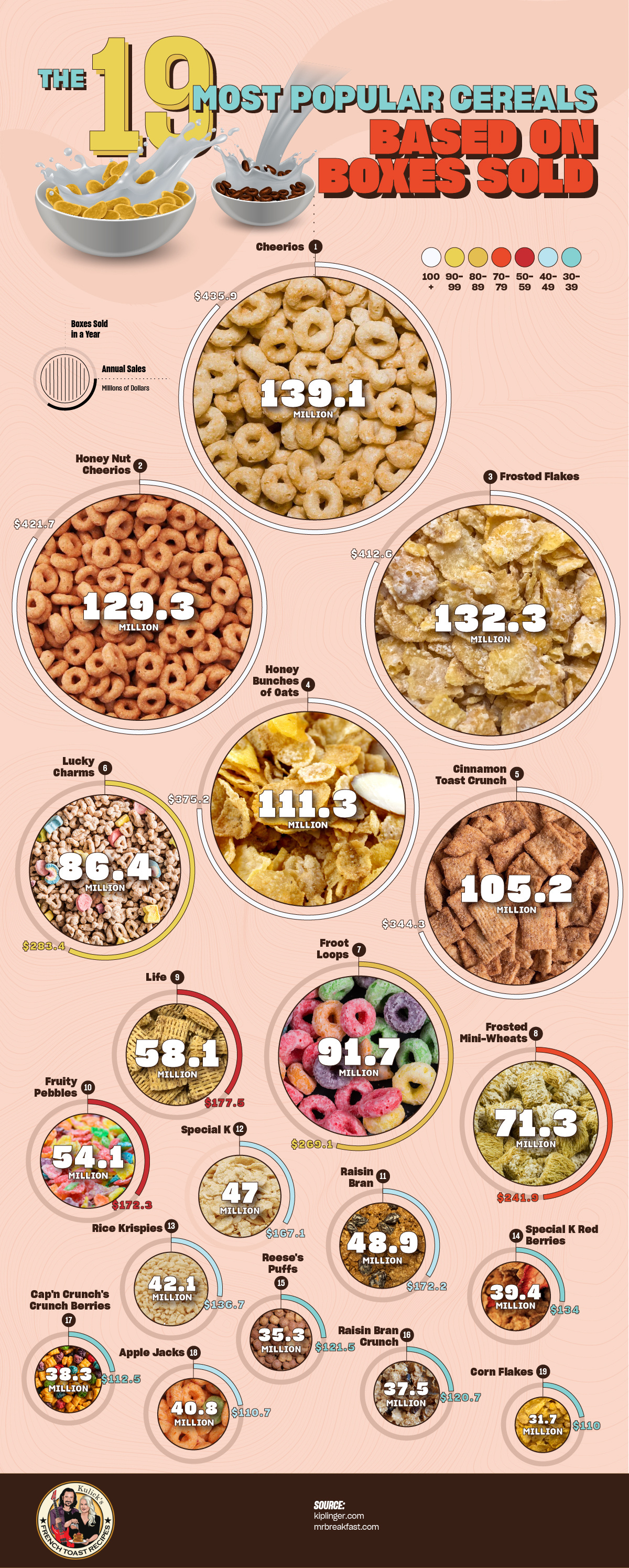The 19 Most Popular Cereals Based on Boxes Sold
What is your favorite cereal? For many people, that answer comes quickly and with gusto. Many of us grew up with fond memories of enjoying a bowl of cereal with cold milk while watching Saturday morning cartoons. Cereal is a beloved comfort food for all ages, with different brands and flavors earning our loyalty over the years. In fact, a 2021 Mintel survey of 1,806 Internet users found that 58% of participants agreed that “the flavors of cereal I enjoyed as a child are still my go-to.”
How much money does cereal make a year? During the first year of the pandemic, U.S. cereal sales surged 9%, fueled by society’s unified desire for convenience, comfort, and nostalgia. So what is the most popular cereal? Kulick’s French Toast Recipes took a look at cereal revenue and boxes sold to find the most popular cereal in the U.S.:

What Is the Best-Selling Cereal in the United States?
Here are the 10 most popular cereals in the United States ranked by annual sales:
- Cheerios sales: $435.9 million
- Honey Nut Cheerios sales: $421.7 million
- Frosted Flakes sales: $412.6 million
- Honey Bunches of Oats sales: $375.2 million
- Cinnamon Toast Crunch sales: $344.3 million
- Lucky Charms sales: $283.4 million
- Froot Loops sales: $269.1 million
- Frosted Mini-Wheats sales: $241.9 million
- Life sales: $177.5 million
- Fruity Pebbles sales: $172.3 million
What Cereal Sells the Most Boxes?
Here are the 10 top-selling cereals based on number of boxes sold:
- Cheerios boxes sold: 139.1 million
- Frosted Flakes boxes sold: 132.3 million
- Honey Nut Cheerios boxes sold: 129.3 million
- Honey Bunches of Oats boxes sold: 111.3 million
- Cinnamon Toast Crunch boxes sold: 105.2 million
- Froot Loops boxes sold: 91.7 million
- Lucky Charms boxes sold: 86.4 million
- Frosted Mini-Wheats boxes sold: 71.3 million
- Life boxes sold: 58.1 million
- Fruity Pebbles boxes sold: 54.1 million
So how many cereal boxes are sold each year in the United States? According to the National Cereal Day website, 2.7 billion cereal boxes are sold annually! That’s enough to wrap around the world 13 times. Another fun cereal fact is that 49% of Americans begin their day with a bowl of cereal.
When Was Cereal Invented?
In 19th century America, morning meals consisted mostly of meat, which lead to digestive issues and constipation due to lack of fiber. This sparked a vegetarian movement that would eventually lead to food reforms. In 1863, a religiously conservative vegetarian named James Caleb Jackson ran a medical sanitarium in western New York. He created a breakfast cereal from graham flour dough that was dried and broken into shapes, which he called Granula. It was so hard that it needed to be soaked in milk overnight. John Harvey Kellogg, a surgeon operating a health spa in Michigan, later made his own version and named it Granola. Inspired by the same concept, a former patient of Kellogg’s, C.W. Post, created Grape-Nuts. This would go on to become the first ever popular product to offer a discount coupon.
| Cereal + Boxes Sold in a Year | Annual Sales |
| Cheerios
139.1 million |
$435.9 million |
| Honey Nut Cheerios
129.3 million |
$421.7 million |
| Frosted Flakes
132.3 million |
$412.6 million |
Honey Bunches of Oats111.3 million |
$375.2 million |
Cinnamon Toast Crunch105.2 million |
$344.3 million |
Lucky Charms86.4 million |
$283.4 million |
| Froot Loops
91.7 million |
$269.1 million |
Frosted Mini-Wheats71.3 million |
$241.9 million |
| Life
58.1 million |
$177.5 million |
| Fruity Pebbles
54.1 million |
$172.3 million |
| Raisin Bran
48.9 million |
$172.2 million |
Special K47.0 million |
$167.1 million |
Rice Krispies42.1 million |
$136.7 million |
Special K Red Berries39.4 million |
$134 million |
Reese’s Puffs35.3 million |
$121.5 million |
Raisin Bran Crunch37.5 million |
$120.7 million |
Cap’n Crunch’s Crunch Berries38.3 million |
$112.5 millio |
Apple Jacks40.8 million |
$110.7 million |
| Corn Flakes
31.7 million |
$110.0 million |
Use the following embed code to post this infographic on your website:
This page was last updated by Bruce Kulick and Lisa Lane Kulick





